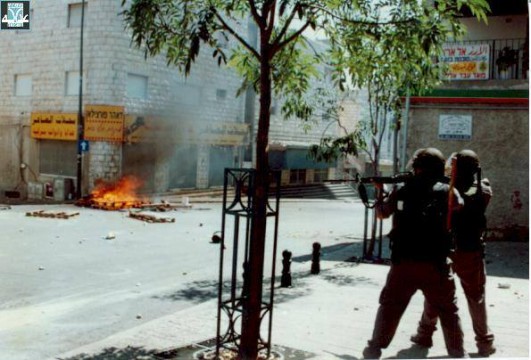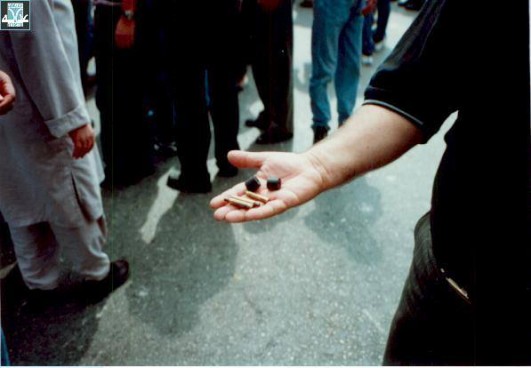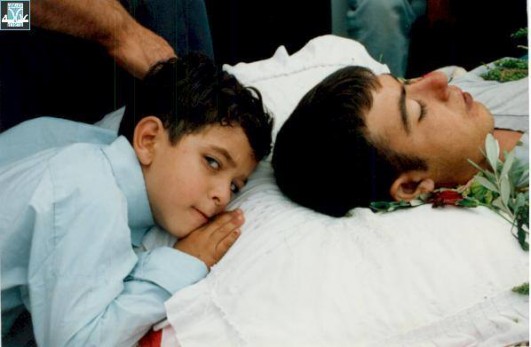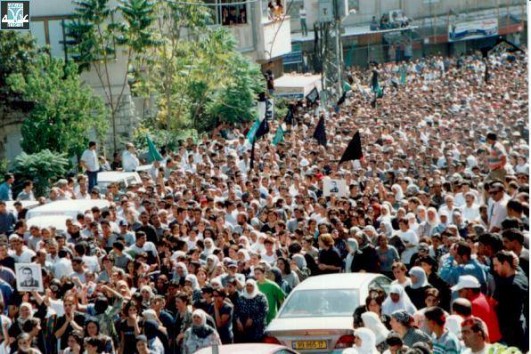During a single week in October of 2000, Israeli Police shot dead 13 Palestinians — 12 of them Israeli citizens — who took to the streets to show solidarity with demonstrators in the West Bank and Gaza. The violence profoundly impacted the Palestinian community in Israel. Just as devastating, however, has been the complete absence of accountability.
A series of photos circulated on social media last week showing people holding portraits of 13 young men. The 13 men were Palestinian Arabs – 12 citizens of Israel and one resident of Gaza – who were killed by Israeli Police in what became known as the “October 2000 events.” The photos read in Arabic: “We carry the memory, we continue the struggle.”
This week Palestinian citizens of Israel, who make up 20 percent of the state’s population, are marking the 15th anniversary of those killings. The events were a significant turning point in the community’s history; but most people in Israel and abroad have long forgotten them, or are completely unaware of the victims’ stories, or have many misconceptions about what occurred that month.
On September 28, 2000, Ariel Sharon, then-leader of the opposition Likud party, made his infamous visit to the Haram al-Sharif/Temple Mount compound escorted by hundreds of Israeli police officers. The move was viewed as a deliberate provocation both against the Palestinian people and against Israel’s negotiations with the PLO, and became the final spark that unleashed the Second Intifada after months of worsening tensions.
Palestinians in East Jerusalem and the occupied territories immediately demonstrated against Sharon’s bellicose move, but were met by Israeli security forces that used lethal force to suppress the protests, killing several Palestinians and injuring scores more.
Targeting citizens
Palestinian citizens in Israel soon organized their own demonstrations in Arab towns and villages across the country, with thousands taking to the streets in solidarity with Palestinians in the territories and in protest of the government’s policies. While the demonstrations were largely non-violent, rioting also occurred with stone-throwing, burning of tires and clashes with police forces.
The state’s response to the demonstrations inside Israel was unprecedented. Israeli police deployed thousands of officers around Arab communities, and more alarmingly, sent special sniper units to accompany the forces. The police and their snipers used live ammunition, rubber-coated steel bullets and tear gas against the crowds. In one week, more than 1,000 protestors were wounded and 660 Palestinians were arrested.
The worst outcomes, however, were the 13 fatalities, nearly all of whom were shot in the chest, head or eyes by live or rubber bullets. On October 1, four Palestinian citizens were killed: 21-year-old Rami Ghara in Jatt; 26-year-old Eyad Lawabny in Nazareth; 23-year-old Mohammed Jabareen in Umm al-Fahem; and 18-year-old Ahmed Jabareen in Mu’awiya.
The next day on October 2, one Palestinian from Gaza and six Palestinian citizens were killed: 19-year-old Misleh Abu Jarad in Umm al-Fahem; 17-year-old Asel Asleh in Arrabe; 18-year-old Ala Nassar in Arrabe; 21-year-old Walid Abu Saleh in Sakhnin; 25-year-old Emad Ghanayim in Sakhnin; and 19-year-old Mohammad Khamayseh in Kufr Kanna.
The day after that, on October 3, one Palestinian citizen was killed: 24-year-old Ramez Bushnaq in Kufr Manda. Five days later, on October 8, two more Palestinian citizens were killed: 42-year-old Omar Akkawi in Nazareth; and 25-year-old Wissam Yazbak in Nazareth.

‘Battle conditions’
October 2000 was not the first time that the Israeli police had used violent methods against Palestinian citizens, nor the first time that protestors were killed by those methods. It was, however, the most deadly incident of state-sanctioned violence against the minority since the Kafr Qassem massacre of 1956, when 49 Palestinian citizens were shot dead while returning to their village during a military curfew.
The killings were particularly shocking because it showed how, despite cautious hope of improvement in the 1990s, Israeli authorities still viewed the Palestinian minority not as citizens to be protected, but as an enemy population to be suppressed. In effect, Israeli forces used the same brutal and lethal tactics against Palestinians within the Green Line as they did against Palestinians under occupation. “This was a case of semi-battling,” claimed one official regarding the police’s approach to the demonstrations; the officers were operating “under conditions of battle,” agreed another.
The scale and consistency of the brutality also made it clear that high-ranking Israeli officials were responsible for sanctioning the police’s methods, including the use of sniper fire. According to evidence brought against the state, these officials not only included commanding officers like Bentzi Sau, the head of the Border Police in the northern district at the time, but even then-prime minister Ehud Barak, who declared on radio that he had “instructed the minister of public security and the police commanders…[that they have] the green light for any action necessary to bring about the rule of law, to preserve public order and to secure freedom of movement for the citizens of the state…”

‘No justification for gunfire’
Shortly after the killings, the families of the 13 victims, represented by the legal center Adalah, began a legal struggle demanding investigations into the October events and the prosecution of all those responsible. Following intense pressure from the families, Arab political representatives and the Arab public, the Israeli government established an official commission of inquiry to examine the events, led by Supreme Court Justice Theodor Or.
Released in 2003, the Or Commission’s report became a landmark document not only for its criticism of the police’s conduct, but for its acknowledgement of the wider historical discrimination faced by Palestinian citizens of the state. The commission first found that there was no justification in Israel’s laws or police regulations for firing live or rubber bullets against the Palestinian citizens, and further found that there was no real threat in any of the cases to justify their use.
Just as significantly, the commission concluded that the Israeli government had to begin efforts on “giving true equality to the country’s Arab citizens,” and to correct the state’s historical views of its minority:
… it is important to act in order to root out the existence of negative prejudices against the Arab sector that were discovered even among experienced and respected officers in the police force. The police must instill among its officers the understanding that the Arab community as a whole is not their enemy, and that it should not be treated as an enemy. – Or Commission Report, pg. 768, para. 15

Demanding justice
The Israeli authorities, however, had no interest in heeding the Or Commission. In a heavily-criticized report in September 2005, the Israel Police’s internal investigations division (“Mahash”) decided not to pursue any indictments against any officers or commanders. Later in January 2007, the attorney general also closed the investigations into the killings. Thus rather than prosecuting those responsible for the crimes, the state created a shield of impunity to help the perpetrators evade punishment. To this day, despite the Or Commission’s specific recommendations, not a single police officer or official has been indicted for the killings.
The police violence in October 2000 profoundly impacted the Palestinian community in Israel. Just as devastating, however, has been the complete absence of accountability for the state’s wrongs during that week. By refusing to set a firm precedent for the October events, the state effectively gave the green light for the police to continue employing brutality against Palestinian citizens, while granting them full impunity for their actions.
Meanwhile, the victims’ families and friends, while enduring the irreconcilable loss of their loved ones, have continued to demand justice for the killings despite a decade and a half of frustration and disappointment. In the midst of their hardships, the online photo campaign hopes to be a reminder to the families that they are not alone in their fight, and that the 13 young men have not been forgotten.



